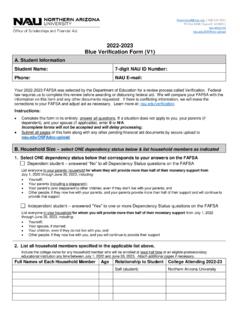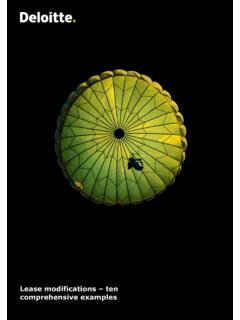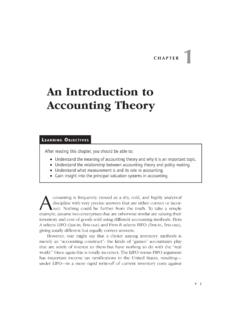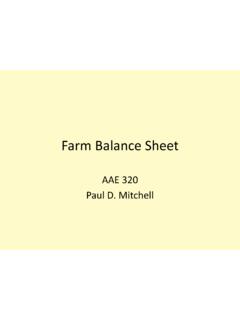Transcription of Accounting Skills Assessment Practice Exam Page 1 of 11
1 Accounting Skills Assessment Practice Exam Page 1 of 11 NAU Accounting Skills Assessment Practice EXAM & KEY 1. A company received cash and issued common stock. What was the effect on the Accounting equation? Assets Liabilities Stockholders Equity A. + NE + B. - NE - C. + + NE D. - - NE 2. A company purchased land by issuing a note payable. What was the effect on the Accounting equation? Assets Liabilities Stockholders Equity A. - - NE B. + + NE C. + NE + D. - NE - 3. Which of the following financial statements is concerned with the financial position of an enterprise at a point in time? A. Retained Earnings Statement. B. Balance Sheet. C. Income Statement. D. Statement of Cash Flows. 4. Cash was collected from a customer on account. Which accounts were debited and credited? Debit Credit A.
2 Accounts Receivable Cash B. Cash Service Revenue C. Cash Accounts Receivable D. Cash Accounts Payable 5. Which pair of accounts is increased by recording a credit? A. Common Stock and Rent Expense. B. Cash and Accounts Receivable. C. Treasury Stock and Common Stock. D. Notes Payable and Service Revenue. 6. Which of the following errors will cause a trial balance to be out of balance? A. A debit to Office Equipment is incorrectly debited to Office Supplies. B. The bookkeeper forgot to journalize a transaction. C. The bookkeeper forgot to post a journal entry to the ledger. D. A credit was posted to an account as a debit. Accounting Skills Assessment Practice Exam Page 2 of 11 7. When a magazine company receives advance payment for a subscription, it A. Debits Cash and credits Subscriptions Revenue.
3 B. Debits Cash and credits Unearned Subscriptions Revenue. C. Debits Unearned Subscriptions Revenue and credits Cash. D. Debits Prepaid Subscriptions and credits Cash. 8. The Supplies account had a $360 debit balance at the end of the Accounting period before adjustment for supplies used, and an inventory of $80 worth of unused supplies were on hand. Which of the following is the required adjusting entry? A. Debit Supplies $280 and credit Supplies Expense $280. B. Debit Supplies Expense $280 and credit Supplies $280. C. Debit Supplies $80 and credit Supplies Expense $80. D. Debit Supplies Expense $80 and credit Supplies $80. 9. A company s weekly payroll of $750 is paid on Fridays. There are five days in a pay period. Assume that the last day of the month falls on Wednesday. Which of the following is the required adjusting entry?
4 A. Debit Unpaid Salaries and credit Salaries Payable for $450. B. Debit Salaries Expense and credit Salaries Payable for $450. C. Debit Salaries Expense and credit Salaries Payable for $300. D. Debit Salaries Payable and credit Salaries Expense for $450. 10. A company had the following balance sheet accounts and balances: Accounts Payable $ 24,000 Cash $12,000 Accounts Receivable 4,000 Common Stock ? Buildings & Equipment (net) 68,000 Retained Earnings 8,000 What is the balance of the Common Stock account? A. $76,000 B. $68,000 C. $60,000 D. $52,000 11. An accountant is preparing adjusting journal entries. Which of the following entries could not possibly be a correct adjusting journal entry? A. Rent Expense 5,000 Rent Payable 5,000 B. Accounts Receivable 5,000 Service Revenue 5,000 C.
5 Interest Expense 5,000 Interest Revenue 5,000 D. Unearned Revenue 5,000 Service Revenue 5,000 12. A company declared cash dividends of $ per share. If there are 500,000 shares of common stock authorized, 100,000 shares issued, and 80,000 shares outstanding at the date of declaration, what is the amount that the company should record for the dividend? A. $4,000 B. $16,000 C. $20,000 D. $100,000 Accounting Skills Assessment Practice Exam Page 3 of 11 13. What is the amount of Income from Operations that a company should report on its current year multiple-step income statement based on the following data? Cost of goods sold $ 250,000 Net sales $ 600,000 Income taxes expense 50,000 Selling, general & Interest expense 25,000 administrative expenses 150,000 A. $350,000 B. $200,000 C. $175,000 D.
6 $125,000 14. A company sold equipment for $100,000; the equipment had cost $300,000 and had accumulated depreciation of $180,000. The company s journal entry to record the sale of the equipment would include a A. Credit to Sale of Equipment for $100,000. B. Credit to Equipment for $120,000. C. Debit to Equipment for $300,000. D. Debit to Loss on Sale of Equipment for $20,000. 15. Which of the following should be classified as a current asset? A. Accounts Receivable. B. Accumulated Depreciation. C. Franchises. D. Land Held for Future Use. 16. Which of the following is most likely to appear on the balance sheet as a current liability? A. Bonds Payable. B. Accumulated Depreciation. C. Long-term Notes Payable. D. Wages Payable. 17. Gross profit equals the difference between net sales and A. Net Income.
7 B. Operating Expenses. C. Cost of Goods Sold plus Operating Expenses. D. Cost of Goods Sold. 18. Under the perpetual inventory system, in addition to making the entry to record a sale, a company would A. Make no additional entry until the end of the period. B. Debit Cost of Goods Sold and credit Inventory. C. Debit Cost of Goods Sold and credit Purchases. D. Debit Inventory and credit Cost of Goods Sold. Accounting Skills Assessment Practice Exam Page 4 of 11 19. The Allowance for Doubtful Accounts is necessary because A. Uncollected accounts that are written off must be accumulated in a separate account. B. When recording Bad Debts Expense, it is not possible to predict specifically which accounts will not be collected. C. Management should know how much in credit losses have occurred over the years.
8 D. A liability results when a credit sale is made. 20. The general ledger account for Accounts Receivable shows a debit balance of $50,000. The Allowance for Doubtful Accounts has a credit balance of $1,000. If management estimates that 5% of Accounts Receivable will prove uncollectible, Bad Debts Expense would be recorded for A. $1,500. B. $2,540. C. $2,500. D. $3,500. 21. Interest on a 3-month, 10 percent, $10,000 note receivable is A. $ 250. B. $2,500. C. $ 288. D. $1,000. 22. The inventory costing method that matches recent costs with recent revenues is A. Last-in, First-out (LIFO). B. First-in, First-out (FIFO). C. Average Cost. D. Specific Identification. _____ Use the following information to answer the next three questions. Beginning inventory 100 units @ $ = $ 800 Purchase # 1 200 units @ $ = 1,200 Purchase # 2 100 units @ $ = 1,200 Total 400 units $3,200 Ending inventory is 150 units.
9 23. What is ending inventory under the average cost method? A. $1,200. B. $2,000. C. $ 300. D. $ 500. 24. What is cost of goods sold under LIFO? A. $1,100. B. $1,700. C. $1,500. D. $2,100. 25. What is cost of goods sold under FIFO? A. $1,500. B. $1,100. C. $1,700. D. $2,100. _____ Accounting Skills Assessment Practice Exam Page 5 of 11 Use the following information to answer the next three questions. Nicholson purchased a piece of equipment on for $60,000. The equipment has an estimated useful life of eight years or 50,000 units of production and an estimated salvage value of $6,000. 26. The amount of depreciation to be recorded for year 2 using the straight-line method of calculating depreciation, is A. $ 7,500. B. $ 6,750. C. $15,000. D. $13,500. 27. The amount of depreciation to be recorded for year 1 using the double-declining balance method, is A.
10 $13,500. B. $ 6,000. C. $15,000. D. $12,000. 28. The amount of depreciation to be recorded in year 1 using the units-of-activity method and assuming that 6,500 units are produced, is A. $4,680. B. $7,800. C. $5,200. D. $7,020. _____ 29. Jones borrowed $960 from the bank, issuing a , 4-month promissory note. Assuming that the note is issued and paid in the same Accounting period, Jones entry on the date of payment will include a A. Debit to Notes Payable for $960. B. Debit to Interest Payable for $40. C. Credit to Cash for $960. D. Debit to Interest Receivable for $40. 30. On June, 30, 2011, Riddle Corporation issued $500,000 of 8%, 5-year bonds at 100. Interest is payable semi-annually. The journal entry to record the semiannual interest payment on December 31, 2011 would credit A.












